Leshan Giant Buddha Scenic Area is located on Lingyun Road, east bank of the Minjiang River in the southern part of Shizhong District, Leshan City, Sichuan Province. It sits at the confluence of three rivers: the Minjiang River, Qingyi River, and Dadu River. As a national 5A-level tourist scenic area, it boasts distinct features, including the Leshan Giant Buddha—the world’s largest existing open-air cliff-carved stone statue. Additionally, it is home to historical relics such as Lingbao Pagoda, Lingyun Mountain, the Giant Reclining Buddha, and Wuyou Mountain, embodying profound cultural heritage and stunning natural scenery. The scenic area covers a total area of 17.88 square kilometers.
History and Culture
The carving of the Leshan Giant Buddha began in the first year of the Kaiyuan era of the Tang Dynasty (713 AD) and was completed in the 19th year of the Zhenyuan era (803 AD), taking approximately 90 years. At that time, the turbulent waters at the confluence of the three rivers frequently caused shipwrecks. Monk Haitong decided to carve a Maitreya Buddha statue to suppress the floods and bless all living beings. The construction process was fraught with difficulties: after Monk Haitong passed away, the project was suspended. Later, Zhangqiu Jianqiong, Wei Gao, and others successively donated their salaries to resume and finally complete the project. When first built in the Tang Dynasty, the statue was called "the Great Maitreya Stone Statue of Lingyun Temple in Jiazhou". Its name evolved through the Song, Ming, and Republic of China periods, and it is now generally known as the "Leshan Giant Buddha". In 1996, the Leshan Giant Buddha was inscribed on the UNESCO World Cultural Heritage List.
Major Scenic Spots
Leshan Giant Buddha
Standing by the three rivers, with hands resting on its knees and backed by nine peaks, the Leshan Giant Buddha sits solemnly against the mountain, with a total height of 71 meters. Specifically, its head is 14.7 meters tall and 10 meters wide, adorned with 1,051 hair buns; its ears are 7 meters long, eyebrows and nose each 5.6 meters long, and mouth and eyes each 3.3 meters long; its neck is 3 meters tall, shoulders 24 meters wide, fingers 8.3 meters long, the distance from knees to insteps is about 28 meters, instep width is 8.5 meters, and nearly 100 people can sit around its instep. On both sides of the Buddha are two stone carvings of Dharma-protecting Heavenly Kings, each over 16 meters tall. There are also hundreds of niches and thousands of stone carvings, forming a magnificent Buddhist art cliff carving landscape. On the left side of the Buddha is the nearly 500-meter-long Lingyun Plank Road, and on the right is the Nine-Turn Plank Road.
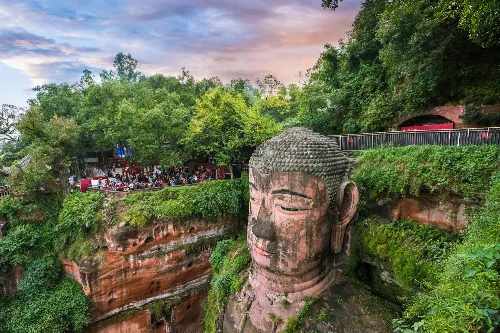

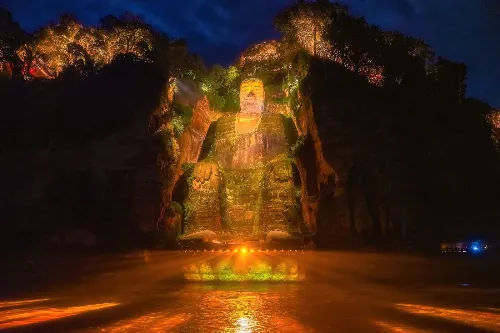
Lingbao Pagoda
Serving as a navigation marker for ships, Lingbao Pagoda is built with blue bricks. It stands 40 meters tall, with a two-layered base (11 meters on each side) and five floors inside. Each floor has arc-shaped windows for lighting, allowing visitors to enjoy a panoramic view of the three rivers. As a symbolic Buddhist pagoda of the ancient Leshan City, it is a key cultural relic protection unit of Sichuan Province and was announced as a national key cultural relic protection unit by the State Council in 2006. It is said that the relics of Monk Haitong are preserved in Lingbao Pagoda.
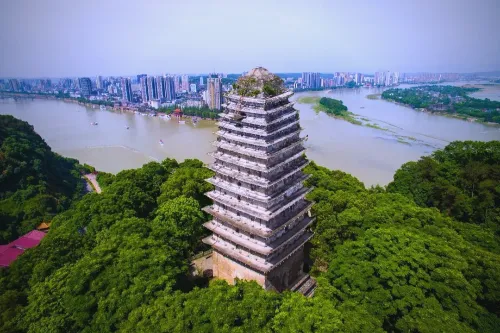
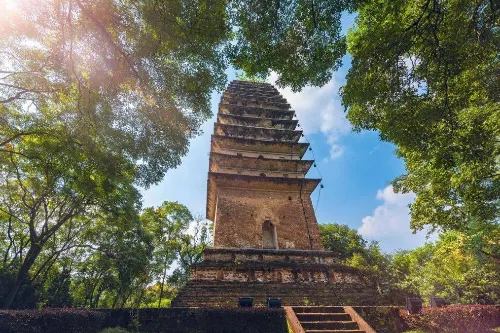
Haishi Cave
Haishi Cave is located at the top of Lingyun Mountain, behind the head of the Leshan Giant Buddha. The words "Haishi Cave" are carved on the cave’s lintel, originally written by Gu Guangxu, the provincial inspector of Sichuan during the Qing Dynasty, and later re-carved by descendants. It is said that Monk Haitong once lived here. There is a bronze bell from the Ming Dynasty in front of the cave, and a seated statue of Monk Haitong outside the cave.

Giant Reclining Buddha
Located on the outskirts of the Leshan Giant Buddha Scenic Area, the Giant Reclining Buddha is over 4,000 meters long. Its head is formed by Wuyou Mountain, its body by the peaks of Lingyun Mountain, and its feet by Guicheng Mountain. The Leshan Giant Buddha sits within the Reclining Buddha, creating a unique landscape that embodies the concepts of "having the Buddha in one’s heart" and "the heart being the Buddha". The area around the Yingchunmen Wharf in the eastern part of the ancient Leshan City is an ideal spot to view the Reclining Buddha.
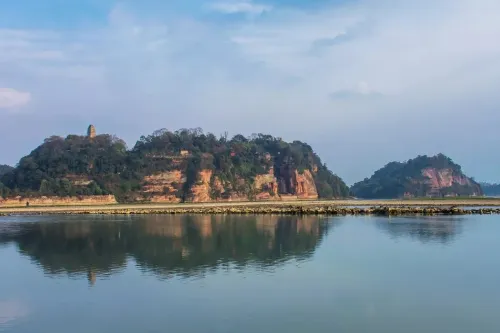
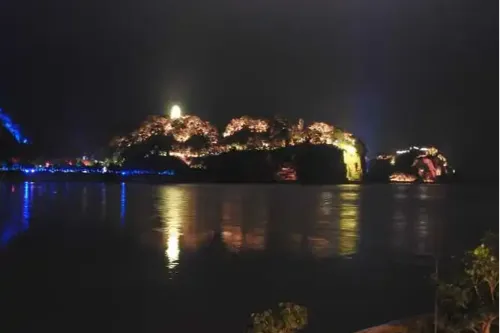
Wuyou Temple
Originally named Zhengjue Temple, Wuyou Temple was founded in the Tang Dynasty and renamed in the Northern Song Dynasty. It is situated on Wuyou Mountain on the east bank of Leshan City. Inside the temple stands the Erya Platform, with the four characters "Zhongliu Dizhu" (a pillar standing firm in the middle of the river) carved beside the platform. Other attractions include the Arhat Hall, Mahavira Hall, Amitabha Hall, Guanyin Hall, Jingyun Pavilion, and the statue of Wuyou Bodhisattva. In 1983, the State Council designated Wuyou Temple as a national key temple in the Han-inhabited areas.
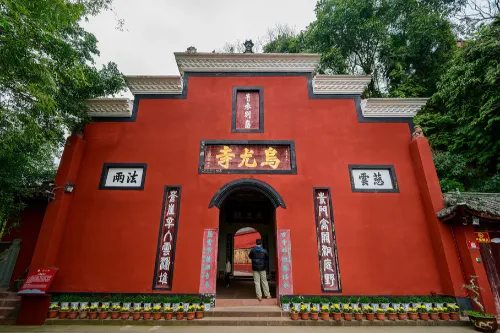
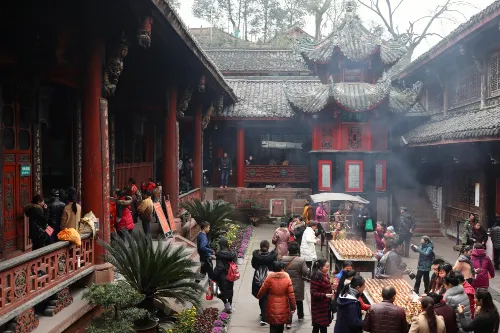
Mahao Cliff Tombs
The Mahao Cliff Tombs get their name from the Mahao River, a flood discharge channel between Lingyun Mountain and Wuyou Mountain. Cliff tombs were a popular burial form in Leshan during the Western and Eastern Han Dynasties. The specific practice was to enclose the deceased in tombs carved into mountain rocks, with the tomb structure fully imitating the deceased’s residence during their lifetime. This reflected the filial piety concept of "treating the deceased as the living" and represented the secular expression of the Han Dynasty’s culture of loyalty and filial piety in funeral customs.
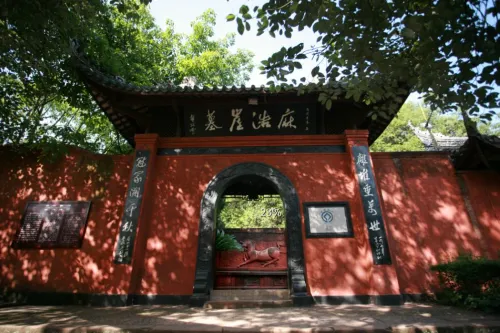

Doushuai Palace
Carved in the Ming Dynasty, Doushuai Palace houses a 2-meter-tall statue of Maitreya Buddha. Also known as "Tushita Heaven" (from Sanskrit), Doushuai Palace can be translated as "Heaven of Wonderful Bliss", "Heaven of Contentment", "Heaven of Joyful Satisfaction", or "Heaven of Delight" in Chinese.
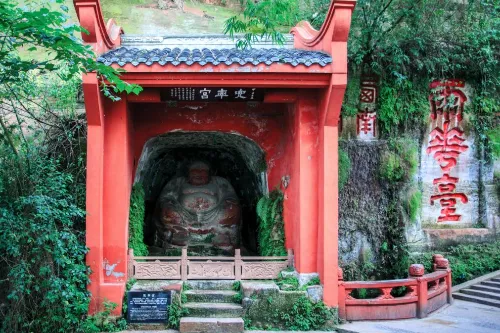
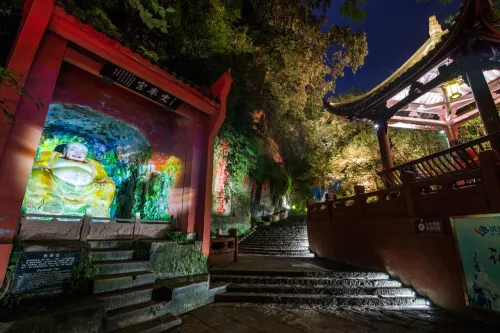
Lingyun Plank Road
Construction of the Lingyun Plank Road began in early 1983, was completed in 1984, and opened to the public in October of the same year. Stretching 500 meters long, it connects to the Giant Buddha at the north end and to Bijin Tower at the south end. Together with the Nine-Turn Plank Road on the right side of the Giant Buddha, it forms a winding tourist route.
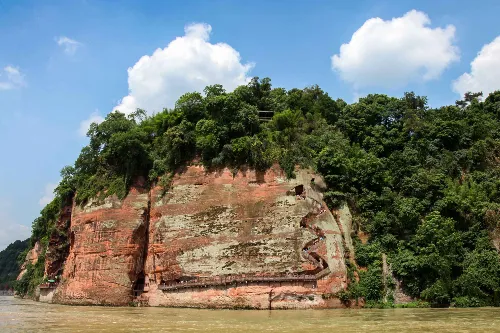
Lingyun Temple
Located at the top of Lingyun Mountain and surrounded by the Nine Peaks of Lingyun, Lingyun Temple is a magnificent complex. Also known as the "Great Buddha Temple" (since it houses the Giant Buddha), it was founded in the Tang Dynasty. Historical records show that its establishment predates the carving of the Giant Buddha, with a history of over 1,300 years.
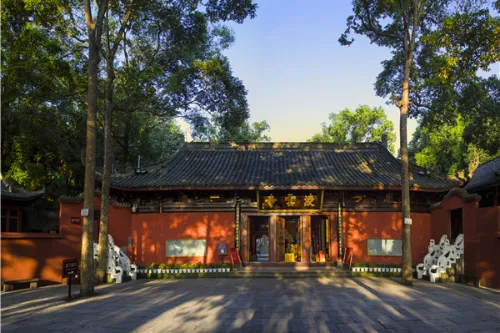
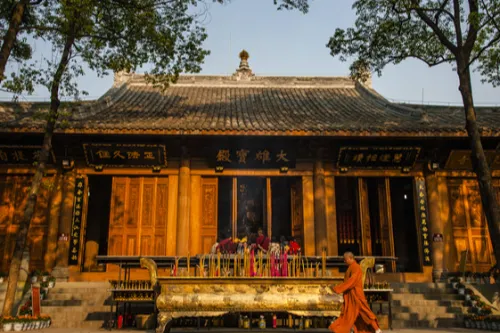
Thousand-Buddha Cliff Carvings
Located on the river-facing cliff at the north gate of the Giant Buddha Scenic Area, the Thousand-Buddha Cliff Carvings were created in the Tang Dynasty. On a 70-meter-long and 10-meter-high cliff, there are 72 square and rectangular niches, with carvings including Buddhas, Bodhisattvas, pagodas, and sutra pillars. The carvings feature vivid shapes and rich themes, such as Maitreya Buddha, Triad Buddhas, Thousand Buddhas, Western Pure Land Transformation, Shakyamuni and Prabhutaratna Buddhas sitting together, Thousand-Hand Guanyin, and pagodas. The carving combinations include one Buddha with three attendants, five figures, and seven figures, among others.
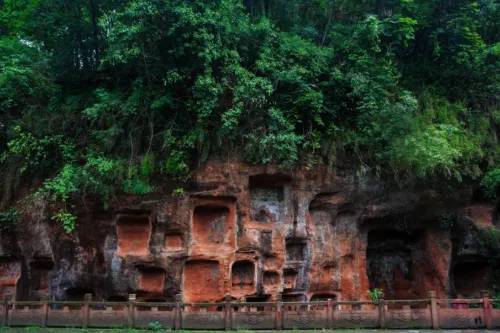
Calligraphy Stele Forest
The Calligraphy Stele Forest exhibits 195 steles engraved with calligraphy works by ancient and modern celebrities. Most of these steles are made by rubbing the ink calligraphy collections of the Giant Buddha Scenic Area, and many of them are rare treasures. Examples include the handwritten inscriptions by Su Dongpo, Huang Tingjian, Zheng Banqiao, as well as modern and contemporary figures such as Kang Youwei, Zhao Xi, Guo Moruo, Zhao Puchu, Li Yimang, Guan Shanyue, and Qian Jiaju.

Tour Route
Enter through the East Gate, first arrive at the Tourist Center to purchase tickets and obtain scenic area information. Then walk about 800 meters to reach the North Gate of the Leshan Giant Buddha, where you can view the Giant Buddha and Lingyun Temple up close. Next, walk along the Nine-Turn Plank Road to enjoy the surrounding scenery and the full view of the Giant Buddha, passing by several viewing platforms along the way. Continue forward to reach Lingbao Pagoda, and climb to the top floor to overlook the entire scenic area. After leaving Lingbao Pagoda, you can visit the museum to gain an in-depth understanding of the historical and cultural background of the Leshan Giant Buddha.
Travel Tips
- From May to November, the climate is pleasant and the scenery is beautiful, making it an ideal time for a visit. However, there are usually more tourists during this period, so it is advisable to plan your trip in advance.
- You can choose to take a cruise ship to view the Leshan Giant Buddha and the Giant Reclining Buddha from the river, which offers a unique perspective.
- The scenic area is home to numerous historical and cultural relics. Hiring a tour guide for explanations will help you better understand the relevant knowledge.
Precautions
- Some areas within the scenic area are relatively slippery, especially the Nine-Turn Plank Road. Please be careful when walking to ensure safety.
- Temperatures are relatively high in summer, so take measures to protect yourself from the sun and prevent heatstroke; in winter, keep warm.
- Abide by the scenic area regulations: do not touch cultural relics arbitrarily or damage the environment.
Transportation
- You can take a bus from the downtown area of Leshan to the scenic area.
- There are direct shuttle buses from Leshan Railway Station to the Giant Buddha.
- Self-driving tourists can park their vehicles in the scenic area's parking lot.
Opening Hours
April 1st - October 7th: 07:30 - 18:30 (last entry at 18:30); October 8th - March 31st of the following year: 08:00 - 17:30 (last entry at 17:30). The actual opening hours shall be subject to the on-site announcement of the scenic area.
Tickets
The ticket price is CNY 80 per person.
You can search for the official WeChat public account of the scenic area "乐山大佛景区" to get the latest updates or purchase tickets online.
Online Booking
Click here to jump to the Trip.com ticketing platform for ticket purchase.


